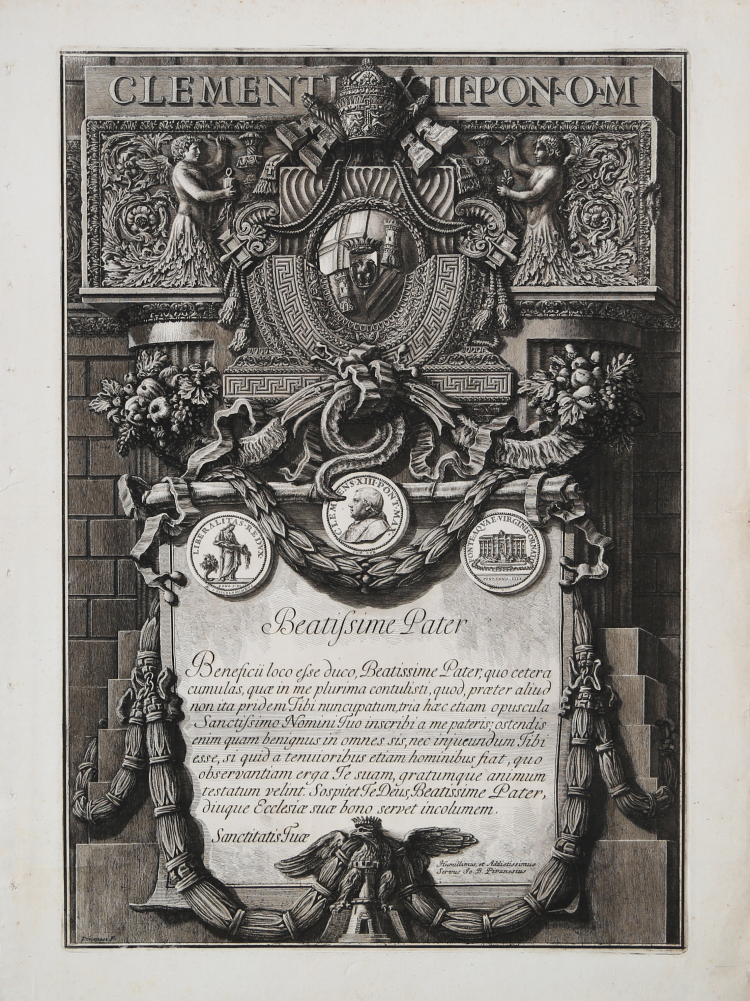




| Reference: | S7605 |
| Author | Giovan Battista PIRANESI |
| Year: | 1761 |
| Measures: | 350 x 505 mm |



| Reference: | S7605 |
| Author | Giovan Battista PIRANESI |
| Year: | 1761 |
| Measures: | 350 x 505 mm |
Etching and engraving, 1761, signed in plate at lower left.
Magnificent proof, printed in brown ink on contemporary laid paper bearing unidentifiable watermark, with wide margins, in excellent condition.
Continuing the publishing series on strictly archaeological subjects begun in 1761, Piranesi in the following year published for the types of Generoso Salomoni a third volume, also in folio, entitled Lapides capitolini sive fasti consulares triumphalesque romanorum. The sumptuous book contains engravings relating to the two frontispieces, one of which is dedicated to Pontiff Clemente XIII Rezzonico. The Lapides Capitolini is a minor, but for that reason no less important, work by Piranesi. The list of Roman magistrates from the time of the kings to the end of the reign of Augustus was had engraved on marble and walled in the Roman Forum by historian Valerius Flaccus. The fragmentary inscriptions were found in 1547 and placed by Michelangelo in an architectural frame, which he designed, on the Capitoline Hill. The work, a minor work by Piranesi, was completed in 1761 and came to light the following year, reproducing the inscriptions according to Michelangelo's placement. As in his previous works, the artist does not limit himself to the work of reproduction by representing the blocks not inserted in the wall, but as if they were resting on shelves or supported by grapples, so as to give them back that three-dimensionality that belongs to them, dwelling on the gaps, breaks and chiseling, presenting them as ruins and as fragments of a lost ancient context.
A work of great architectural suggestion, this sheet dedicated to Pope Clement XIII can be considered as a true monument that goes along with the architectural inventions, he executed in the church of Santa Maria del Priorato on the Aventine.
Bibliografia
Petrucci, 1953, n. 390, p. 264; Focillon, 1967, n. 421, p. 312; Wilton-Ely, 1994, n. 553, p. 607; Ficacci, 2000, n. 477, p. 388.
Giovan Battista PIRANESI (Mogliano Veneto 1720 - Roma 1778)
|
Italian etcher, engraver, designer, architect, archaeologist and theorist. He is considered one of the supreme exponents of topographical engraving, but his lifelong preoccupation with architecture was fundamental to his art. Although few of his architectural designs were executed, he had a seminal influence on European Neo-classicism through personal contacts with architects, patrons and visiting artists in Rome over the course of nearly four decades. His prolific output of etched plates, which combined remarkable flights of imagination with a strongly practical understanding of ancient Roman technology, fostered a new and lasting perception of antiquity. He was also a designer of festival structures and stage sets, interior decoration and furniture, as well as a restorer of antiquities. The interaction of this rare combination of activities led him to highly original concepts of design, which were advocated in a body of influential theoretical writings. The ultimate legacy of his unique vision of Roman civilization was an imaginative interpretation and re-creation of the past, which inspired writers and poets as much as artists and designers.
|
Giovan Battista PIRANESI (Mogliano Veneto 1720 - Roma 1778)
|
Italian etcher, engraver, designer, architect, archaeologist and theorist. He is considered one of the supreme exponents of topographical engraving, but his lifelong preoccupation with architecture was fundamental to his art. Although few of his architectural designs were executed, he had a seminal influence on European Neo-classicism through personal contacts with architects, patrons and visiting artists in Rome over the course of nearly four decades. His prolific output of etched plates, which combined remarkable flights of imagination with a strongly practical understanding of ancient Roman technology, fostered a new and lasting perception of antiquity. He was also a designer of festival structures and stage sets, interior decoration and furniture, as well as a restorer of antiquities. The interaction of this rare combination of activities led him to highly original concepts of design, which were advocated in a body of influential theoretical writings. The ultimate legacy of his unique vision of Roman civilization was an imaginative interpretation and re-creation of the past, which inspired writers and poets as much as artists and designers.
|